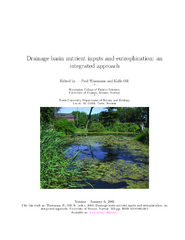| dc.description.abstract | Eutrophication is an increase in primary production due to increased nutrient supply and its consequences. In its widest sense eutrophication means any increase of nutrient availability that increases primary production. Frequently, however, eutrophication is understood exclusively as the consequence of nutrient input by anthropogenic activities. The primary consequence of eutrophication in aquatic environments is an enhancement of algal productivity and accumulation of algal
biomass. Secondary consequences are changes in community structure of plankton and benthos. Man-induced eutrophication or changes in biodiversity are nothing new: they are a well-known consequence of human culture. Eutrophication phenomena accompanied all human settlements.
Even in the early days of mankind human activities
resulted in ecosystem changes. Several
large animals such as the mammoth survived the
glacial periods, but not the last one. It has been
suggested that Neolithic hunters decimated this
species to extinction. Similar suggestions have
also been made regarding other large mammals
that did not continue to exist after the last glacial.
The main sewage canal in the city of Rome,
‘cloaca’, has given rise to a number of expression
regarding sewage pathways in numerous languages.
Since classical and medieval times there
have been ‘clean-ups’ of unsanitary, plague-ridden
cities. Eutrophication is thus the oldest environmental
problem of human civilization and not a
recent phenomenon. However, with the significant
increase of human population over recent decades,
eutrophication has developed from a more or less
local to a global issue. Due to changes in human
living conditions and the declining number
of people employed in agriculture, the population
in the coastal zone increases steadily. The nutrient
concentration increases continually from small
streams over rivers and larger lakes to the estuaries.
The consequences of this, such as discoloured
waters, ‘rotten’ bottom water, odour and reduced
fishing yields are obvious to even a casual observer.
The combined effect of increasing human population
and movement to the coastal zone, the environmental
pressure on rivers, estuaries and shelf
regions results in an ever-increasing pressure on
the entire coastal zone (Figure 1). Consequently,
eutrophication turns into an escalating global phenomenon
as long as the human population increases.
Homo sapiens has thus a vital impacton nature that is part of its culture. As a consequence
of that we have to distinguish between
natural and cultural eutrophication. In most of
this text the term eutrophication stands for cultural
eutrophication. | en |


 English
English norsk
norsk


